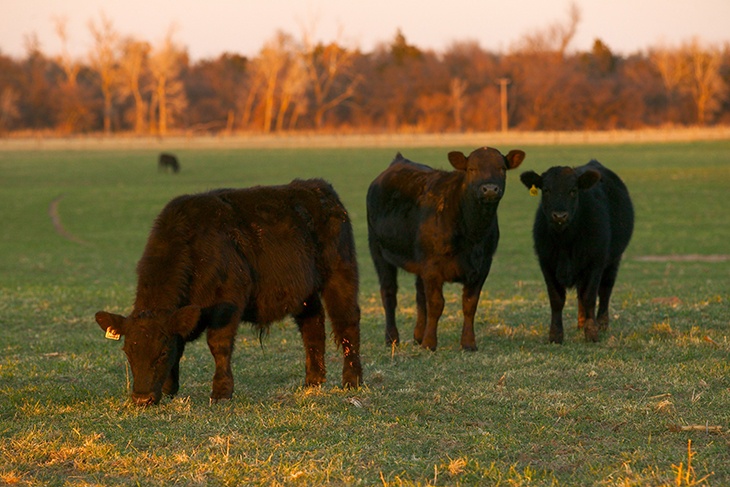Blake Allen follows up on his first article about switching to and running a stocker operation, going into more detail about considerations for folks thinking about this option.
I spent several years reading about and talking to folks about stock calves before I ever bought any animals. Such careful planning and diligent research is critical to success. You must understand the economics and business structure, different types of forages, various illnesses and diseases, facilities, and much more before thinking about buying any animals. If you’re considering a stocker operation, here are some of the things you should think about.

Start With Your Competitive Advantage
Figuring out a profitable and sustainable business model is first and foremost. This begins with determining your competitive advantage in your area. In my part of the world, we have lots of fescue-based pastures and cheap calves in the fall of the year. Buying calves in the fall and wintering them on stockpiled fescue gives me my competitive advantage. For a northern operation, your advantage is likely to be summer grazing. If you have deep snow on the ground from November through April, wintering calves isn’t going to be nearly as easy for you as it is for me. However, grass gains during the warmer months are typically better in northern than southern areas. In the deep south and areas of the southern plains, winter annuals are widely available and grow through most of the winter. Use your forage and local market conditions to your advantage.
Explore Financing Options
Once you have determined what your advantage is, start thinking about how to set up the financial aspects of your business. Will you need to borrow a large amount of money to buy the cattle? This is typically the case with farming in today’s world. We borrow the money and hope to make enough to pay it back and keep a little for ourselves. If you have an established operation, look around your farm or ranch for things you can sell to finance the cattle. Unused equipment or equipment that is not frequently used can tie up a lot of capital. These items can be sold, with the proceeds invested into livestock that are appreciating in value. The same holds true for cows that are over six or seven years of age.
If you are starting completely from scratch, try to save enough money to buy some of the cattle yourself. An even better option may be custom grazing for others until you get some experience handling calves and are able to save enough money to buy your own cattle.
Understand Margins
It is important to understand that the stocker business is a margin business. The margin is the amount between gross sales price and purchase price, minus your expenses. Another important concept to understand is that you shouldn’t figure your profits from selling a group of cattle until their replacements are bought back. To stay in business long term, you must sell one animal, buy another to replace it, and deduct your expenses. Then you can figure your profit. This is known as sell-buy marketing. There are several books, articles, and even schools that cover this topic in great detail in its relation to cattle marketing.
Make Sure You Have the Right Forage
After you’ve figured out how to structure your business, take a look at your grass. There is a huge difference between cow quality grass and stocker quality grass. Cows can get by and give you a calf off of mature or low quality forage. Stockers may stay alive, but they aren’t likely to gain much on this kind of grass. Stockers require a higher quality diet than mature animals, meaning more protein and TDN (Total Digestible Nutrients). One of the best ways to provide this is through incorporating legumes in your pastures, as well as keeping grasses in a vegetative state. A diverse pasture with 30-35 percent legumes will give you a better chance of success grazing stocker calves. Research high quality grasses and legumes that perform well in your area, and figure out what you need to do to introduce these species to your pastures and keep them there.
Sharpen Your Cattle Health and Nutrition Skills
While you’re waiting on your pastures to become well established for stocker grazing, start looking into cattle health and nutrition. These two are closely tied together. For most cow-calf operators, health problems may include a few calving issues, a case of pinkeye or scours here and there, some footrot, and perhaps an occasional case of pneumonia. For stocker operations, that is not the case. In a stocker operation, you are likely to have more sick animals, and at times more death loss than a typical cow calf operation would. There are ways to mitigate and lessen illness in purchased calves, but it takes some careful study and practice.

Stress is the primary cause of cattle getting sick. Stress can be caused by weaning, transporting, handling, weather changes, feed changes, change of scenery, new herd mates, and a variety of other things. Just about all of these stressors occur when you buy sale barn cattle, and many of them happen with cattle purchased straight off the farm of origin. To be successful running a stocker operation, it is critical to become very good at taking stress off of calves as soon as they arrive until the day they leave. While weaned, vaccinated, farm fresh cattle are an option to buy, they will cost a good bit more and you lose one of the best opportunities to add value yourself. Feedlots and other finishing operations often don’t have the time or labor resources required to buy unweaned calves. They may do it if they have to, but most would rather buy a group of hard, long weaned yearlings that have had all of their inoculations prior to shipping. One of the main reasons why the stocker portion of the industry exists is to take small, unweaned, or mismanaged cattle and prepare them for the finishing stage. I will cover receiving and starting calves, identifying and treating sick ones, nutrition, and all of the other things that go along with this topic in a different article.
Fix Fences and Facilities

Facilities for stockers are an often overlooked area. If the calves you buy are not weaned, they are going to look for a hole in the fence to go find mama for the first several days you have them. A receiving lot with a good woven wire or board fence, along with one or two strands of hot wire is a must have for newly purchased cattle. After the calves are trained to a hot wire, four strand perimeter fences and one or two strand interior electric fences are typically adequate. A corral with a way to separate and restrain sick calves for treatment is usually necessary, as well as a way to load them on a trailer or truck. Corrals don’t have to be fancy or expensive, but they should function well and allow you to handle the cattle with as little stress as possible. Access to clean water throughout the pasture is essential, with piped water into a stock tank being ideal.
Is This For You?
I am not advocating everyone sell their cows and only run stockers. This enterprise can be a sideline to a cow/calf operation, a seasonal enterprise in years with more than normal grass, or just something new for folks to consider. For others, just running cows may be the best option.
If you are interested in trying some stockers despite the risks involved, do plenty of research and figure out what works in your area. Learn as much as you can and talk to as many experienced operators as you can, get your farm set up properly, and then start thinking about actually buying some cattle. Proper planning is essential to success.
Read the next in this series: Making the Business of Backgrounding Work for You.
Did you miss Blake’s first article? Why I Made the Switch to Stockers: Profit and Flexibility.





Hey Blake, nice to see a fellow North Carolinian on here. Your dead right about cattle prices being low in the fall here. I run a nursery pig operation here in the eastern part of the state and run cattle on the waste application fields. I held my spring born calves till late winter this year and vaccinated with Triangle 10 and Vision 7 plus wormed them before sale. They had been weaned about 5 months. The steers brought about $.50/ lb. more than the calves Dad sold in the late summer/ fall. So I think you are right on course. Our pasture is bermuda with winter annual overseed for comparison. I grazed corn stalks with a lot of volunteer corn in them last year also.
Your dead right on thinking things out also. If you haven’t already, I would recommend reading Management Intensive Grazing and Year Around Grazing both by Jim Gerrish as they are very insightful and a good step toward profitability.
Nice to see another young man farming against the odds, Chad
Blake, I’m brand new to the cattle business. I so new in fact that I’m still working on getting some property leased.
Reading your articles are making me think about a start up stocker operation on the 33 acres I’m trying to lease. I;m from NE Ohio so I would probably be a spring to Dec. operation.
Here is the newbie question , Where would be the best place for me to look at to sell off these stockers in the late fall? Thanks Barry
Blake,
I appreciate your effort in taking the time write the follow-articles to your first one. Your system or managing the stocker operation is what makes it profitable. You’ve clearly invested the time, and money into learning how to create a system that works.
Comments are closed.